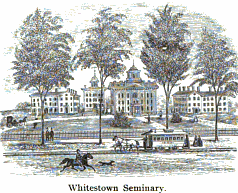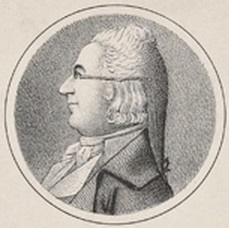|
Oneida Institute
The Oneida Institute ( ) was a short-lived Presbyterianism, Presbyterian school in Whitesboro, New York, United States, that was a national leader in the emerging Abolitionism in the United States, abolitionist movement. Existing from 1827 to 1843, the school was radical and the first that accepted both Black people, Black and White people, White students in the United States. According to Earnest Elmo Calkins, Oneida was "the seed of Lane Seminary, Case Western Reserve University#Western Reserve College (1826–1882) and University (1882–1967), Western Reserve College, Oberlin College, Oberlin and Knox College (Illinois), Knox colleges." The Oneida Institute was founded in 1827 by George Washington Gale as the Oneida Institute of Science and Industry. His former teacher (in the Addison County Grammar School, Middlebury, Vermont, 1807–1808) John Frost, now a Presbyterian minister in Whitesboro with Harriet Lavinia (Gold) Frost his wife — daughter of Thomas Ruggles Gold, — ... [...More Info...] [...Related Items...] OR: [Wikipedia] [Google] [Baidu] |
Oneida Community
The Oneida Community ( ) was a Christian perfection, perfectionist religious communal society founded by John Humphrey Noyes and his followers in 1848 near Oneida, New York. The community believed that Jesus had Hyper-preterism, already returned in AD 70, making it possible for them to bring about Millennialism, Jesus's millennial kingdom themselves, and be perfect and free of sin in this world, not just in Heaven (a belief called ''Christian perfection, perfectionism''). The Oneida Community practiced Intentional community, communalism (in the sense of communal property and possessions), group marriage, Coitus reservatus, male sexual continence, Oneida stirpiculture (a form of eugenics), and mutual criticism. The community's original 87 members grew to 172 by February 1850, 208 by 1852, and 306 by 1878. There were smaller Noyesian communities in Wallingford, Connecticut; Newark, New Jersey; Putney, Vermont, Putney and Cambridge, Vermont. The branches were closed in 1854 except ... [...More Info...] [...Related Items...] OR: [Wikipedia] [Google] [Baidu] |
Thomas Ruggles Gold
Thomas Ruggles Gold (November 4, 1764 – October 24, 1827) was a United States representative from New York. Biography Born in Cornwall, Connecticut, he pursued classical studies and was graduated from Yale College in 1786. He studied law, was admitted to the bar and commenced practice in Goshen, Connecticut. He settled in Whitesboro, Oneida County, New York, in 1792 and was assistant New York attorney general from 1797 to 1801. He was a member of the New York State Senate from 1796 to 1802 and was an unsuccessful candidate for election in 1804 to the Ninth Congress. He served in the New York State Assembly in 1808 and was elected as a Federalist The term ''federalist'' describes several political beliefs around the world. It may also refer to the concept of parties, whose members or supporters call themselves ''Federalists''. History Europe federation In Europe, proponents of deep ... to the Eleventh and Twelfth Congresses, holding office from March 4, 1809, to ... [...More Info...] [...Related Items...] OR: [Wikipedia] [Google] [Baidu] |
Western, New York
Western is a town in Oneida County, New York, United States. The population was 1,951 at the 2010 census. The Town of Western is an interior town of Oneida County, north of Rome. History The town was first settled ''circa'' 1789. The Town of Western was formed in 1797 from the Town of Steuben. In 1811, part of Western was used to form the newer Town of Lee. Town of Western, today There is no active senior citizens group that meets monthly for activities. The Western Town Library offers programs for children and adults, and the historical society provides lectures and events for those registered as a part of the Historical Society. There is currently one church in Westernville, the First Presbyterian Church on Stokes-Westernville Road. North Western has one church, the United Methodist Church, located on Route 46. The Town of Western did hold the Heritage Days every year with the last in 2012. This is the location of Gen. William Floyd's second home, and is also where he ... [...More Info...] [...Related Items...] OR: [Wikipedia] [Google] [Baidu] |
Erie Canal
The Erie Canal is a historic canal in upstate New York that runs east–west between the Hudson River and Lake Erie. Completed in 1825, the canal was the first navigability, navigable waterway connecting the Atlantic Ocean to the Great Lakes, vastly reducing the costs of transporting people and goods across the Appalachians. The Erie Canal accelerated the settlement of the Great Lakes region, the westward expansion of the United States, and the economic ascendancy of New York (state), New York state. It has been called "The Nation's First Superhighway". A canal from the Hudson River to the Great Lakes was first proposed in the 1780s, but a formal survey was not conducted until 1808. The New York State Legislature authorized construction in 1817. Political opponents of the canal (referencing its lead supporter New York Governor DeWitt Clinton) denigrated the project as "Clinton's Folly" and "Clinton's Big Ditch". Nonetheless, the canal saw quick success upon opening on October ... [...More Info...] [...Related Items...] OR: [Wikipedia] [Google] [Baidu] |
Hamilton College
Hamilton College is a Private college, private Liberal arts colleges in the United States, liberal arts college in Clinton, Oneida County, New York, Clinton, New York. It was established as the Hamilton-Oneida Academy in 1793 and received its charter as Hamilton College in 1812, in honor of Alexander Hamilton, one of its inaugural trustees, following a proposal made after his death in 1804. Since 1978, Hamilton has been a coeducational institution, having merged with its sister school, Kirkland College. Hamilton enrolled approximately 2,000 undergraduate students as of the fall of 2021. The curriculum offers 57 areas of study, including 44 majors, as well as the option to design interdisciplinary concentrations. The student body consists of 53% female and 47% male students, representing 45 U.S. states and 46 countries. The acceptance rate for the class of 2026 was 11.8%. Hamilton's athletic teams participate in the New England Small College Athletic Conference. History Hamilto ... [...More Info...] [...Related Items...] OR: [Wikipedia] [Google] [Baidu] |
Galesburg, Illinois
Galesburg is a city in Knox County, Illinois, United States. The city is northwest of Peoria, Illinois, Peoria. At the 2010 United States Census, 2010 census, its population was 32,195. It is the county seat of Knox County and the principal city of the Galesburg micropolitan area, Galesburg Micropolitan Statistical Area, which includes all of Knox and Warren County, Illinois, Warren counties. Galesburg is home to Knox College (Illinois), Knox College, a private four-year liberal arts college, and Carl Sandburg College, a two-year community college. A section of the city is listed on the National Register of Historic Places as the Galesburg Historic District. History Galesburg was founded by George Washington Gale, a Presbyterian minister from New York (state), New York state who had formulated the concept of the manual labor college and first implemented it at the Oneida Institute near Utica, New York, Utica, New York. In 1836 Gale publicized a subscription- and land purchase ... [...More Info...] [...Related Items...] OR: [Wikipedia] [Google] [Baidu] |
Theodore Dwight Weld
Theodore Dwight Weld (November 23, 1803 – February 3, 1895) was one of the architects of the American abolitionist movement during its formative years from 1830 to 1844, playing a role as writer, editor, speaker, and organizer. He is best known for his co-authorship of the authoritative compendium '' American Slavery as It Is: Testimony of a Thousand Witnesses'', published in 1839. Harriet Beecher Stowe partly based '' Uncle Tom’s Cabin'' on Weld's text; the latter is regarded as second only to the former in its influence on the antislavery movement. Weld remained dedicated to the abolitionist movement until slavery was ended by the Thirteenth Amendment to the United States Constitution in 1865.Columbia 2003 Encyclopedia Article Columbia 2003 Encyclopedia Article According to [...More Info...] [...Related Items...] OR: [Wikipedia] [Google] [Baidu] |
Lane Rebels
Lane Seminary, sometimes called Cincinnati Lane Seminary, and later renamed Lane Theological Seminary, was a Presbyterian theological college that operated from 1829 to 1932 in Walnut Hills, Ohio, today a neighborhood in Cincinnati. Its campus was bounded by today's Gilbert, Yale, Park, and Chapel Streets. Its board intended it to be "a great ''central theological institution'' at Cincinnati — soon to become the great Andover or Princeton of the West." However, the founding and first years of Lane were difficult and contentious, culminating in a mass student exodus over the issue of slavery, or more specifically whether students were permitted to discuss the topic publicly, the first major academic freedom incident in America. There was strong pro-slavery sentiment in Cincinnati, and the trustees immediately prohibited further discussion of the topic, to avoid repercussions. With the city being on the border of the South, a lot of fugitive slaves and freedmen went through ... [...More Info...] [...Related Items...] OR: [Wikipedia] [Google] [Baidu] |
Syracuse, New York
Syracuse ( ) is a City (New York), city in and the county seat of Onondaga County, New York, United States. With a population of 148,620 and a Syracuse metropolitan area, metropolitan area of 662,057, it is the fifth-most populated city and 13th-most populated municipality in the state of New York (state), New York. Formally established in 1820, Syracuse was named after the classical Greece, Greek city Syracuse, Sicily, Syracuse (''Siracusa'' in Italian), a city on the eastern coast of the Italian island of Sicily, for its similar natural features. It has historically functioned as a major Intersection (road), crossroads, first between the Erie Canal and its branch canals, then of the Rail transport in the United States, railway network. Today, the city is at the intersection of Interstates Interstate 81, 81 and Interstate 90, 90, and its Syracuse Hancock International Airport, airport is the largest in Central New York, a five-county region of over one million inhabitants. Sy ... [...More Info...] [...Related Items...] OR: [Wikipedia] [Google] [Baidu] |
Syracuse University Press
Syracuse University Press, founded in 1943, is a university press that is part of Syracuse University. It is a member of the Association of University Presses. Domestic distribution for the press is currently provided by the University of North Carolina Press's Longleaf Services. History SUP was formed in August 1943 when president William P. Tolley promised Thomas J. Watson that the university will organize a press to print IBM's ''Precision Measurements in the Metal Workings Industry''. Matthew Lyle Spencer of the School of Journalism became the first chair of the board of directors and Lawrence Siegfried was the first editor. About The areas of focus for the Press include Middle East studies, Native American studies, peace and conflict resolution, Irish studies and Jewish studies, New York State, television and popular culture, sports and entertainment. The Press has an international reputation in Irish studies and Middle East studies. The Press has never owned its o ... [...More Info...] [...Related Items...] OR: [Wikipedia] [Google] [Baidu] |
Mohawk River
The Mohawk River is a U.S. Geological Survey. National Hydrography Dataset high-resolution flowline dataThe National Map accessed October 3, 2011 river in the U.S. state of New York (state), New York. It is the largest tributary of the Hudson River. The Mohawk flows into the Hudson in Cohoes, New York, a few miles north of the state capital of Albany, New York, Albany.Mohawk River , The Columbia Gazetteer of North America The river is named for the Mohawk Nation of the Iroquois, Iroquois Confederacy. A major waterway, in the early 19th century, the river's east-west valley provided the setting and water for development of the Erie Canal, as a key to developing New York. The largest tributary, the Schoharie Creek, accounts for over one quarter (26.83%) of the Mohawk River's Drainage basin, watershed. Another main tributary is the West Canada ... [...More Info...] [...Related Items...] OR: [Wikipedia] [Google] [Baidu] |








